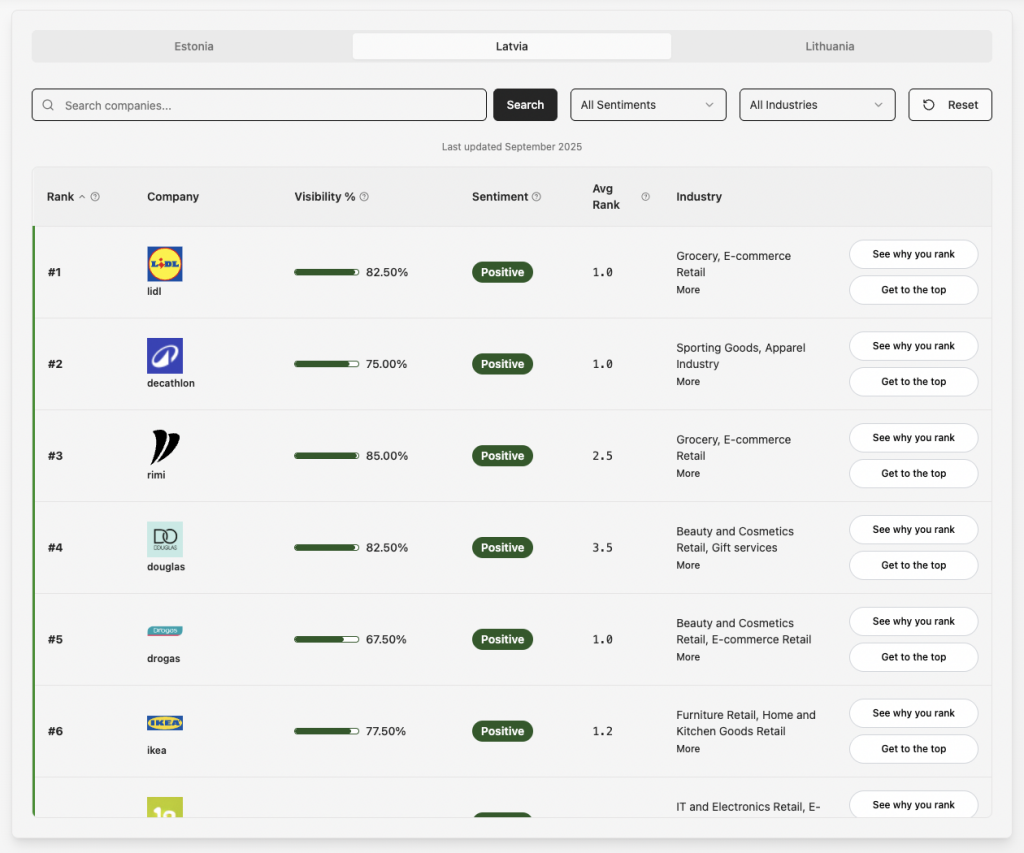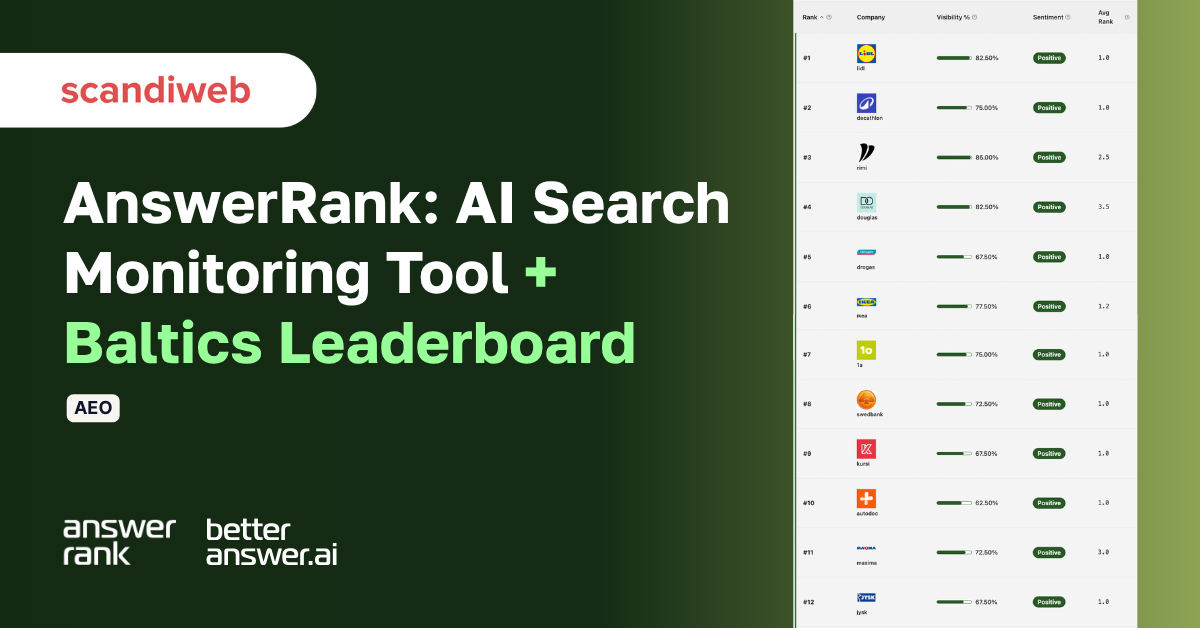Does ChatGPT recommend your brand to customers?
That question used to sound futuristic. Today, it’s urgent. AI assistants like ChatGPT, Gemini, and Perplexity are already really influencing buying decisions. They’re replacing Google searches with natural conversations and AI-generated recommendations, and customers trust them.
What’s inconvenient is that brands don’t get notified when they’re mentioned – there’s no dashboard showing how AI tools perceive them, or whether they appear at all. And when they do show up, the facts might be wrong, outdated, or biased toward competitors.
The current situation inspired the creation of AnswerRank, our AI search monitoring tool. We wanted to bring clarity to an unpredictable space and demonstrate to brands how they appear in AI-generated answers, while also providing clear, actionable ways to improve.
The problem with AI search
AI search introduces an entirely new logic to optimization. The main reason is that ChatGPT and others don’t behave like Google, e.g., by showing a list of links or highlighting ads. Instead, they generate a single, authoritative-sounding answer. Where that answer comes from and why it mentions one brand over another is often a black box that even experienced SEO professionals are struggling to decode.
- Each AI engine is trained differently – ChatGPT, Gemini, and Perplexity use different models, data sources, and logic.
- Answers change without warning, so a brand that shows up today might disappear tomorrow.
- AI can invent facts, hallucinate citations, and confuse brand names.
- There used to be (until AnswerRank) no visibility to track where your brand appears, how often, or how it compares to competitors.
The solution: AnswerRank
AnswerRank is a tool built specifically to track how brands appear in AI-generated answers and help them show up more frequently, with more control.
Developed by SEO experts with 20+ years of experience, AnswerRank was born out of frustration with how unpredictable and unaccountable AI search had become. If people are asking ChatGPT where to shop, what to buy, or who to trust, brands deserve to know how they’re showing up in those answers, and what to do about it.

What you can do with AnswerRank:
- Track your brand’s visibility across ChatGPT, Gemini, and Perplexity
- Benchmark against competitors to see who’s winning
- Analyze sentiment to understand how AI tools portray your brand’s voice
- See sources and citations used by AI to generate answers
- Generate optimized answer snippets that help LLMs interpret your brand accurately
- Get improvement suggestions backed by expert logic.
AnswerRank takes the data and creates a plan. Then, during 1:1 sessions with an AEO strategist, brands can interpret the results and develop a personalized action plan to improve rankings across AI tools.
Also read:
Tracking Brand Mentions in LLM AI-Generated Answers
Coming soon in AnswerRank
As the technology behind AI-generated answers continues to change, AnswerRank is building new tools to help brands keep up. Stay tuned, as several powerful features are already in development to go beyond visibility metrics and deliver deeper insights:
- Semantic query grouping to understand how AI clusters customer questions by intent, helping you tailor content to how people actually think and ask
- Answer theme clustering to see which topics dominate AI answers about your brand or industry, and which ones you’re missing out on
- AI answer snippets to generate optimized answers that align with how ChatGPT and others structure replies
- Real-time insights to catch shifts in visibility as they happen.
AnswerRank live leaderboard
To help brands understand their current standing and what’s possible, we launched the first AI Search Visibility Leaderboard for the Baltic region.
The leaderboard reveals which brands are already showing up in ChatGPT, Gemini, and Perplexity when customers ask real-world questions like:
“Where to buy running shoes in Latvia?”
“Best gifts for a 3-year-old in Lithuania?”
“Which supermarkets are cheapest in Estonia?”
We analyzed over 1,000 brands across 25 industries, using 40 AI search queries per sector. The ranking reveals how visible each brand is in AI-generated answers, ranked by:
- Visibility percentage – how often the brand is mentioned
- Ranking position – whether it appears in the top result
- Sentiment – how the brand is described
- AI source citations – what content influenced the result.
The leaderboard is live and updated regularly, explore it at leaders.answerrank.ai.
Key findings from the leaderboard
Latvia
The top 10 most visible brands in AI-generated answers include a mix of international giants and regional leaders: Lidl, Decathlon, Rimi, Sportland, Douglas, Drogas, IKEA, 1A, Swedbank, Kursi, and Autodoc.

Some of these brands achieve over 80% visibility across tools like ChatGPT and Perplexity, consistently appearing in top responses to common customer questions. Others in the same categories barely register at all.
Top-performing industries:
- eCommerce Retail with 22 of the top 100 brands; Lidl at the top
- Children’s Products – 14 brands, including Babycity
- Beauty & Cosmetics – 12 brands, with Douglas at the top
- Gift Services – 12 brands, led by Lieliska Dāvana
Sectors falling behind: Healthcare Services, HoReCa, and Wholesale Retail.
Estonia
Estonia’s top-ranking brands in AI search are largely from the ticketing and events industry. Fienta (#1), Piletitasku (#3), Piletilevi (#4), and Piletikeskus (#15) all rank within the top 20, showing high visibility and strong average positions.

While eCommerce brands are present, their visibility is more scattered compared to Latvia. Notable retail performers include:
- Rahva Raamat (#2) – strong cross-category presence in Books and Media and eCommerce Retail
- PetCity (#5) – best-performing Pet Retailer
- Motonet (#7) and Autodoc (#9) with solid visibility in Auto Parts & Accessories
- Kaup24 (#8) and IKEA (#23), representing General Home & Kitchen Goods.
Still, many well-known retail names such as Selver (#32) and Sportland (#19) are further down the list with 32.5% visibility or less, suggesting room for growth in AI-driven discoverability.
Home Improvement and DIY have multiple entries (Puumarket, Bauhof, K-Rauta), signaling growing AI recognition of this vertical. Beauty and Cosmetics Retail (e.g., MyLook, Notino, ilu) is gaining traction, but with moderate visibility, none surpassing 36%.
Lithuania
In Lithuania, the AnswerRank leaderboard reveals a strong showing from local and regional champions, many of which outperform global players in AI visibility. The top three brands include pet supply chain Kika (80.42%), ticketing service Tiketa (80%), and Bilietai.

Gjensidige, Lietuvos Draudimas, and Ergo all rank in the top 10, showing that even highly regulated industries can be visible in AI-generated results when content and mentions align.
Retail categories perform well overall, but there’s a noticeable tilt toward specialized verticals. Pet product retailers like Kika, PetCity, and Pet24 appear consistently in the top 25. Similarly, Beauty and Cosmetics is a strong category, with Douglas, Notino, and Drogas close to the top.
Global grocery chains, such as IKI, Maxima, and Lidl, rank lower despite having high brand awareness. This suggests that in AI search, local relevance and content structure may outweigh pure brand recognition. As AI-generated answers increasingly guide customers toward purchases and decisions, the Lithuanian leaderboard illustrates the value of early visibility and how local players are capitalizing on the opportunity.
How brands can influence AI search
Just like traditional SEO, visibility in AI-generated answers is related to the information these models consume. What shows up in AI answers is determined by a mix of:
- Foundational training data (what the LLM was trained on)
- Web-crawled content (recently indexed online data)
- Owned eCommerce data (your product catalog, site structure, FAQs, etc.)
- External signals (brand mentions, reviews, local sources, media, social)
Brands that want to influence LLM responses need to strategically engage across these layers.
Here’s our 6-step framework to begin improving your presence in AI answers:
- Choose your LLM focus
Start with the engines your customers are actually using (whether it’s ChatGPT, Gemini, Perplexity, or another); each has different behaviors and training methods.
- Define target prompts
Figure out the types of questions your ideal customers ask and which ones you want to be the answer to. Think like a customer, not a marketer.
- Benchmark visibility
Use tools like AnswerRank to assess your brand’s visibility today in various search engines and prompt types, and identify any gaps.
- Speak with LLMs
Optimize your site structure, content, and product data to reflect how LLMs understand and rank information – format for snippets, use semantic cues, and write in clear, human-first language.
- Understand sources
Analyze which sources AI tools rely on to form their answers. Are they quoting your competitors? Are you mentioned in relevant media or directories? This step is essential to understanding how authority is calculated in the absence of traditional search rankings.
- Actionize content & strategy
Translate your insights into changes: update product descriptions, restructure category pages, publish answers to customer questions, and strengthen your brand’s digital footprint through strategic partnerships and earned media.
These six steps form the basis of AEO (answer engine optimization). With the right approach, brands can go from being invisible to becoming the top AI-recommended choice.
Brands that track and improve their visibility are the ones to be recommended most. In a world where customers increasingly ask ChatGPT what to buy or where to go, being part of the answer is everything.
Your customers are asking AI – make sure the answer is you! Try AnswerRank, or book a free 1:1 strategy session with an AEO expert today.


Share on: